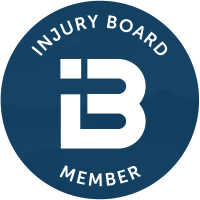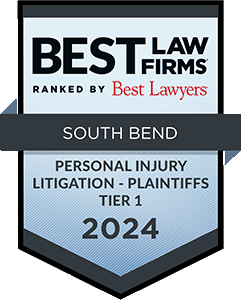 Right-of-way laws are important to know and understand. The driver who violates them is likely to be the liable party if a crash occurs.
Right-of-way laws are important to know and understand. The driver who violates them is likely to be the liable party if a crash occurs.
Below, we discuss what drivers, pedestrians and cyclists should know about Indiana’s right-of-way laws.
If you are injured in an accident because someone failed to yield the right-of-way, you may be eligible to pursue compensation for your damages. Our South Bend car crash lawyers are prepared to help you file a claim.
The initial consultation is free. There are also no upfront fees while we work on your case.
What Are the Right-of-Way Laws at Intersections?
There are different types of intersections, and each one has its own set of rules when it comes to who has the right of way.
Controlled Intersections
A controlled intersection is one where there is an automated traffic light.
The vehicles that have the green light or green arrow have the right-of-way, and those with a red light must come to a full stop.
If a driver making a right turn has a red light, he or she must come to a full stop as well before making the right turn when the way is clear.
Drivers making a left turn while the light is green at a controlled intersection must yield to oncoming traffic. The same goes for drivers making a U-turn, but these drivers must also yield to anyone making a right turn.
Uncontrolled Intersections
An uncontrolled intersection is one where there is either a four-way or two-way stop sign.
When there is a four-way stop sign, all drivers approaching the stop sign must come to a full stop. If more than one driver approaches the stop sign at the same time, then the driver to the right has the right-of-way. He or she may proceed after coming to a full stop.
If the intersection is between a main road and side street, there is likely to be a two-way stop sign on the side street. The drivers with the stop sign must come to a full stop and wait while the drivers on the main road pass through, as they have the right-of-way. Once the road is clear, the drivers turning onto or crossing over the main road may proceed.
Three-Way Intersections
A three-way intersection forms a “T” shape. This is usually when one road ends while intersecting with another. These intersections may have a stop sign, yield sign, a flashing red light or a flashing yellow light. Each one has its own meaning.
If there is a yield sign on the road that ends, the approaching driver must yield to oncoming traffic. Once the road is clear, he or she may proceed with caution. A flashing yellow light means the same thing.
For a stop sign or a flashing red light, the approaching driver must come to a full stop, ensure the way is clear and then proceed.
What Are the Right-of-Way Laws at Roundabouts?
Also known as a traffic circle, roundabouts are also technically considered an intersection.
The difference is that traffic flows in a counterclockwise circular motion and there are no stop signs. Instead, there are yield signs at each roundabout entry point.
The vehicles already in the roundabout have the right-of-way, so those attempting to enter the traffic circle must yield.
What Are the Right-of-Way Laws While Entering a Highway?
When a driver attempts to enter a highway, he or she must use extra caution as the drivers already on the highway have the right-of-way.
Drivers entering the highway must speed up and merge onto the highway when there is enough space and distance between vehicles.
It is important to note that although drivers already on the highway have the right-of-way, they do not have the right to speed up and prevent another vehicle from entering the highway safely.
Understanding Right-of-Way When Sharing the Road with Emergency Vehicles
An emergency vehicle that has its emergency lights and sirens turned on has the right of way in almost every situation. Including if that vehicle has a red light at an intersection. Other drivers must stop and allow an emergency vehicle to pass through an intersection safely.
If a driver is sharing a lane with an emergency vehicle, he or she must switch lanes as soon as possible to allow the vehicle to pass through. If there is no room to change lanes, then the driver of the non-emergency vehicle must pull over to the side of the road so long as it is safe to do so.
What Are the Pedestrian and Cyclist Right-of-Way Laws?
Pedestrians and cyclists usually have the right-of-way when sharing the road.
Drivers maneuvering at an intersection must yield to those in the crosswalk. This means a driver making a right, left or U-turn must wait for the crosswalk at an intersection to be clear before making the turn.
Pedestrians do not have the right-of-way if they are at a controlled intersection and there is a “do not cross” sign. Pedestrians outside of a crosswalk also do not have the right-of-way. They must yield to oncoming traffic. In Indiana, people who cross the street outside of a designated crosswalk are jaywalking, which is a fineable offense.
Cyclists must adhere to the laws of controlled and uncontrolled intersections as well. They may not proceed when a traffic light is red except when making a right turn. However, just like a vehicle, the cyclist must come to a full stop and wait for the way to be clear. Cyclists must also adhere to rules set for drivers.
Who Is Liable if an Accident Occurs?
If a driver fails to yield the right of way to others and a collision occurs, he or she will likely be held liable.
If a pedestrian or cyclist fails to yield the right-of-way, however, that individual will likely only be partially liable for the damages. This is because drivers are expected to take additional precautions when interacting with pedestrians and cyclists.
There are some unique circumstances when a pedestrian or cyclist may be entirely liable for an accident, though. Each case is different, so it is important to discuss this with an experienced attorney.
Call an Experienced Attorney Today
If you were injured by a negligent party, you have the right to pursue compensation for your damages.
Our lawyers have decades of combined experience and are prepared to help.
Call (844) 678-1800 to schedule a free consultation and discuss your situation.











